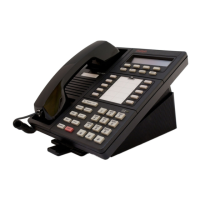MERLIN LEGEND Communications System Release 6.1
Feature Reference
555-661-110
Issue 1
August 1998
Features
Page 701Transfer
Mode Differences 48
Behind Switch Mode 48
In Behind Switch mode, when the fixed Transfer button is pressed, the Transfer
feature of the host switch is used instead of the system’s Transfer feature.
However, to activate Transfer, the fixed Transfer button on an MLX or analog
multiline telephone must be programmed through system programming to send a
timed flash plus the code expected by the host. The fixed button has no effect
when pressed during an intercom call within the communications system; inside
transfers are made using trunk-to-trunk transfer on prime lines. If use of the
communications system’s Transfer feature is also desired (to lower traffic on
prime lines, for example), it must be programmed on an available line button on
each multiline telephone through either extension programming or centralized
telephone programming, and then can be used only when transferring within the
local system (this option is not available in Hybrid/PBX or Key mode). One-touch
Hold is the factory setting in Behind Switch mode. The selection of one-touch
Transfer is not blocked in system programming, but the setting is always one-
touch Hold regardless of the option chosen.
In Behind Switch Mode, the Transfer Return Time and Type of Transfer options
apply only to inside transfers (ICOM/SA calls made within the communications
system) in which the caller, the transfer originator, and the transfer destination are
all system extensions.
Telephone Differences 48
Queued Call Consoles 48
A QCC operator uses the Start and Release buttons or a DSS button to transfer
calls. However, pressing the Transfer button on a QCC is the same as pressing
the Start button.
A QCC operator cannot make or receive voice-announced transfers.
When a QCC operator uses the Start and Release buttons to transfer a call, the
QCC return ring interval applies for transfer return timing instead of the transfer
return time. The QCC return ring interval is the number of rings (1–15) before an
unanswered extended call returns to the QCC queue. See “Queued Call Console
(QCC)” on page 543 for additional details.
Single-Line Telephones 48
The One-Touch Transfer option does not apply to single-line telephones.
Single-line telephone users cannot make voice-announced transfers. In releases
prior to 6.0, a single-line telephone user cannot transfer an outside call to an
outside number. If the user tries to complete a trunk-to-trunk transfer, the caller

